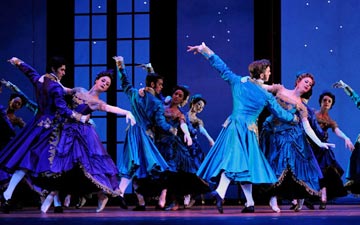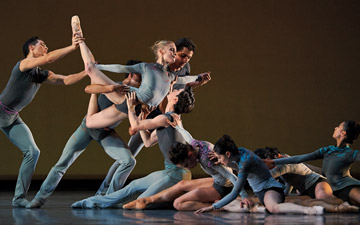
© Erik Tomasson. (Click image for larger version)
San Francisco Ballet
Cinderella
★★★✰✰
Washington, Kennedy Center Opera House
26 October 2016
www.sfballet.org
www.kennedy-center.org
After a four-year hiatus, the San Francisco Ballet returned to the Kennedy Center Opera House in October with a seven-performance run of Cinderella. A joint venture of two major companies, the Dutch National Ballet and San Francisco Ballet, this production was created by British-born choreographer Christopher Wheeldon, one of the major voices in today’s world of dance. The Dutch troupe premiered the ballet in Amsterdam, in 2012.
Just like his productions of Alice’s Adventures in Wonderland and The Winter’s Tale, presented at the Kennedy Center by the National Ballet of Canada in 2013 and 2016, respectively, Wheeldon’s Cinderella is a theatrical extravaganza of epic scale, with whimsical concept, captivating set designs, handsome costumes and breathtaking special effects – a winning result of the choreographer’s collaboration with playwright Craig Lucas, set designer Julian Crouch, lighting designer Natasha Katz and puppeteer Basil Twist.

© Erik Tomasson. (Click image for larger version)
This is a Cinderella with a twist: this staging discards some of the most iconic moments of the beloved fairy tale. We don’t see a magic pumpkin, a fairy godmother and a bunch of helpful mice; and there is no fateful clock striking midnight. In his libretto, following a darker Brothers Grimm telling of Cinderella, Lucas gives the familiar plot a number of unexpected turns and, by doing so, brings it closer to a real-life story.
In the ballet’s opening scene, we meet the main heroine as a little girl in a brief idyllic moment of her childhood as she happily plays outdoors with her parents. After her mother’s sudden death, the girl is introduced to her new stepfamily – her stepmother, Hortensia, who is a hopeless drunk, and her two annoying stepsisters, Clementine and Edwina – whom Cinderella greets with a rebellious feat.
In the first act the action swiftly moves between the Cinderella’s gloomy household and the Royal Palace, where we see the Prince Guillaume as a young boy, playing in a lavishly decorated parlor with his best friend, Benjamin, who is a commoner.
When the grown Prince is pressed by his parents to marry a titled princess, he swaps identities with Benjamin while delivering the wedding invitations to his guests. When the two young men show up at the Cinderella’s house, her stepsisters flirt and fawn on the fancily-dressed Benjamin, while Cinderella shows a true kindness of heart to Guillaume, disguised as a beggar. Attracted to the charming fellow who makes her laugh and teaches her how to dance, Cinderella falls in love with Guillaume without knowing his royal status.
From start to finish, this production abounds in stage magic. In Act I, the tears that the little Cinderella sheds at her mother’s grave give rise to a fantastical tree that grows tall and wide; its foliage flickers with life and changes colors with each season. This wondrous tree, and its continuous transformations, is one of the most spectacular elements of this production. The audience gasped in awe, when, at the end of the first act, the tree turned into a magnificent four-wheel chariot, powered by giant puppet-headed horses, to take the glamorously-clad Cinderella to the ball and her new destiny. The palace décor, featuring a multitude of crystal chandeliers, is another eye-catching sight. During the wedding celebrations of Act III, chandeliers descend through the branches of the tree as if uniting the worlds of Cinderella and her Prince.
Yet for all its narrative surprises and witty designs, this Cinderella is a curiously underwhelming work when it comes to the choreography. The romantic duets for Cinderella and the Prince look appealing and virtuosic but ignite no emotional spark and show no dramatic urgency. The Prince’s friendship with Benjamin enjoys a far better choreographic treatment here than his blossoming romance with the protagonist.
Performed in bizarre wigs, the variations for the Spirits (or the Seasons) are only minimally enchanting; the goofy antics of the stepfamily look more irksome than funny; and the frolics of the three foreign brides are simply dreadful.
On the bright side, the choreography for the enigmatic fates (performed by four gold-masked men in blue-and-black costumes), who are constantly present in this production to protect and guide the title heroine, brims with intrigue and imagination and gives this Cinderella a special aura of mystery. The shoe-fitting sequence of the third act is a comic marvel; and the extensive ballroom dances for the corps have a mighty sweep and bring a potent dramatic force to the ballet, helped by the powerful Prokofiev score.

© Erik Tomasson. (Click image for larger version)
On opening night, the pliant Maria Kochetkova danced with fluid lyricism and gentle grace, giving us a delicate, waif-like Cinderella. Joseph Walsh was wonderfully charming and vibrant as a dashing and good-natured Prince Guillaume. Taras Domitro made a delightful, fun-loving Benjamin; and Sarah Van Patten as Hortensia, Sasha De Sola as Edwina and Ellen Rose Hummel as Clementine handled the grotesqueries of Cinderella’s stepfamily with an admirable comic panache.
The Opera House orchestra under the baton of Martin West was in great shape, rendering the dark, brooding sonorities of the score with a superb expressivity and heart-rending poignancy.

















You must be logged in to post a comment.